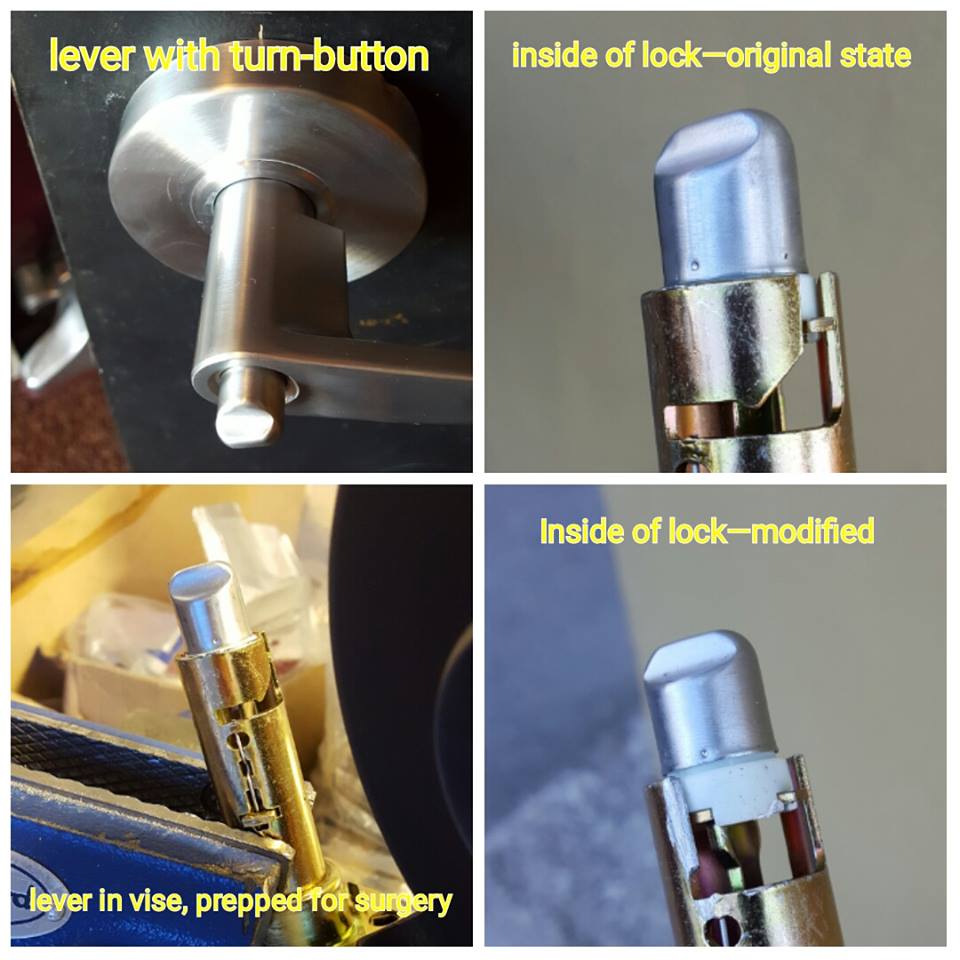Last week I got a call from a restaurant in Woodinville that wanted to replace the failing hardware on its bathroom doors. I suggested I come by with a couple of commercial-grade privacy levers and put them on the doors. Privacy knobs and levers are what we have on our own bathrooms and bedrooms. They lock from the inside more as an indicator of occupancy than an obstacle to entry. They can be unlocked without a key – sometimes with a toothpick or skewer through a little hole on the outside half, and sometimes using a coin in a slot that sort of looks like a keyhole. The restaurant manager said he’d prefer keyed entry levers to provide a real sense of safety in his single-occupancy bathrooms. And he needed this done quickly.
I had reservations, but did as the customer asked. Most commercial-grade knobs and levers have a key difference from residential-grade ones. Rather than having a simple button to lock the door or a turnpiece to lock it, there’s a turn-button that both pushes AND turns. When you just push the button in, the door remains locked until 1) someone opens it with a key from the outside or 2) someone turns the knob or lever from the inside, whereupon the button pops out to the unlocked position. But if you push AND turn, the door remains locked until the turn-button is deliberately returned to the unlocked position (by twisting back to the unlocked position). The trouble is that from the inside, the door always feels unlocked, so you can always turn the knob or lever and walk out without unlocking the door. This is how almost all commercial-grade keyed levers function, and it often causes lockouts. But this is what I installed because it was all I could get quickly to meet the customer’s specifications.
As I drove from the restaurant to the next job, I was kicking myself for not pushing back harder on installing those locks. The management had the keys to the bathroom in case a customer accidentally left one of the doors locked, but I realized it was way too likely that customers would walk into a bathroom, push and twist the turnpiece upon entry, and then walk out of the bathroom without thinking to unlock the door. I wondered to myself how long it would be before I got a call from them. Sure enough, before I’d reached my next job the manager of the restaurant had reached the same conclusion and wanted me to come back to change the locks.
I wasn’t available to return until the next day, so I had a bit of time to think about a solution. These were relatively expensive entry levers I put on his doors, and since they had been installed in bathrooms, it wouldn’t have been right for me to put them back in the boxes and sell them as new to someone else, even if they’d only been in use for half a day. I didn’t want to charge the customer more because I knew I was at fault for failing to stridently object to that lock option. I also didn’t want to eat the cost of these locks myself.
So I came up with another solution. I disabled the turn function on the turn-buttons, so whether a customer pushed or pushed and turned, the doors would never remain locked upon being opened. This was NOT a factory setting. I did this by removing a piece of metal from the lock with a cutoff tool. On the fully assembled lock, there was no visible change to the hardware. But inside the lock, a piece of the chassis had been removed. Since making this change (see photos below) I have not gotten a callback. However, these were ANSI Grade 2 levers, rated for 400,000 cycles. Maybe my alteration will significantly shorten the life of the locks. If I get called back to this restaurant in a few weeks, months, or years, I’ll come back to this post and edit it into a cautionary tale about how not to fix a lock.

 Commercial
Commercial 


